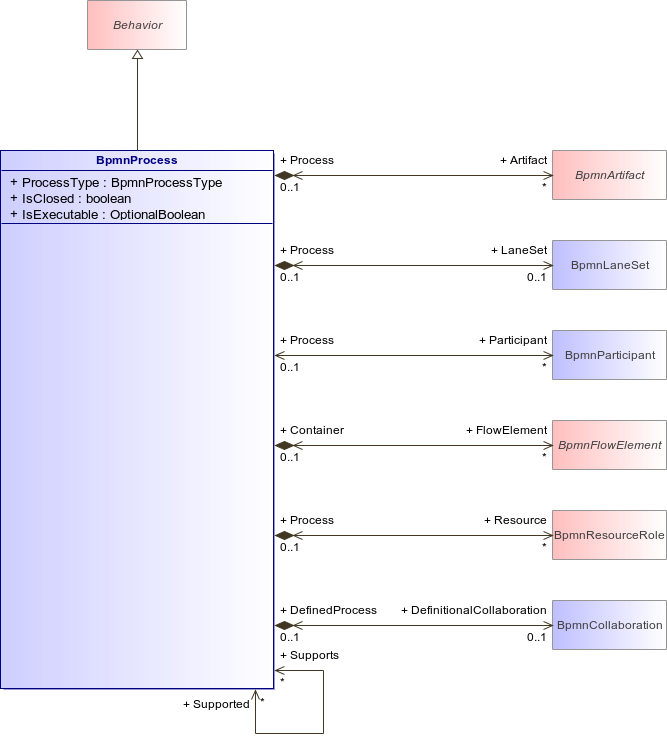
UML/BPMN Metamodel
A Process describes a sequence or flow of Activities in an organization with the objective of carrying out work.
In BPMN a Process is depicted as a graph of Flow Elements, which are a set of Activities, Events, Gateways, and Sequence Flow that define finite execution semantics.
Processes may be defined at any level from enterprise-wide Processes to Processes performed by a single person. Low-level Processes may be grouped together to achieve a common business goal.
Note that BPMN uses the term Process specifically to mean a set of flow elements. It uses the terms Collaboration and Choreography when modeling the interaction between
Processes Ownership: In Modelio, a Process is a Behavior so belongs to any UML element that can contain a Behavior. BPMN Process will usually be created in UML Packages, but may also be found to a Class or an Operation.


Attribute | Description |
|---|---|
BpmnProcessType ProcessType [1..1] | The processType attribute Provides additional information about the level of abstraction modeled by this Process. A public Process shows only those flow elements that are relevant to external consumers. Internal details are not modeled. These Processes are publicly visible and can be used within a Collaboration . Note that the public processType was named abstract in BPMN 1.2 . A private Process is one that is internal to a specific organization. By default, the processType is "none", meaning undefined. |
boolean IsClosed [1..1] | A boolean value specifying whether interactions, such as sending and receiving Messages and Events, not modeled in the Process can occur when the Process is executed or performed. If the value is true, they MAY NOT occur. If the value is false, they MAY occur. |
OptionalBoolean IsExecutable [1..1] | An optional Boolean value specifying whether the Process is executable. An executable Process is a private Process that has been modeled for the purpose of being executed according to the semantics of Chapter 14 (see page 442). Of course, during the development cycle of the Process, there will be stages where the Process does not have enough detail to be 'executable.' A non-executable Process is a private Process that has been modeled for the purpose of documenting Process behavior at a modeler-defined level of detail. Thus, information needed for execution, such as formal condition expressions are typically not included in a non-executable Process. For public Processes, no value has the same semantics as if the value were false. The value MAY not be true for public Processes. |
Association | Description |
|---|---|
Modelers can declare that they intend all executions or performances of one Process to also be valid for another Process. This means they expect all the executions or performances of the first Processes to also follow the steps laid out in the second Process. | |
laneset of the process. The process is represented in this cas by a pool which is decomposed by lansets and lanes. | |
When a participant is decomposed by a process, both are related by this association. | |
Resources attached to the process, such as auditing or monitoring. These resources can be defined externally, in particular by the user, in order to attach descritpion properties to a process. | |
For Processes that interact with other Participants, a definitional Collaboration can be referenced by the Process. The definitional Collaboration specifies the Participants the Process interacts with, and more specifically, which individual service, Send or Receive Task, or Message Event, is connected to which Participant through Message Flows. The definitional Collaboration need not be displayed. Additionally, the definitional Collaboration can be used to include Conversation information within a Process. |